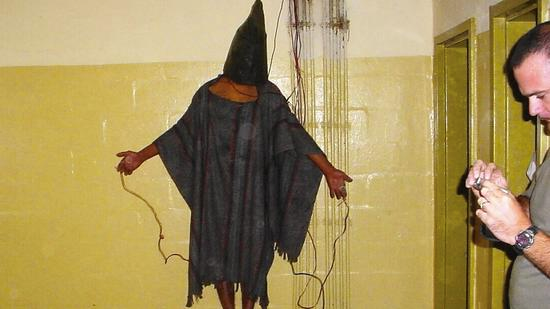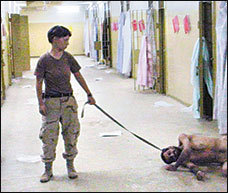In 2004, photos of Iraqi prisoners tethered to dog leashes and electrical wires dominated the news. The centre of the scandal was Abu Ghraib - one of the world’s most notorious prisons. At the time, the US was occupying Iraq following their 2003 invasion, and Abu Ghraib was being used by US troops to detain thousands of Iraqi citizens - in the most repulsive and unsettling conditions. This shameful photo, showing tortured Iraqi Ali Shallal al-Qaysi, has come to symbolise the American led occupation, and the repugnancy it involved.
The man in the most famous image from Abu Ghraib Prison in Iraq
In 2004, photos of Iraqi prisoners tethered to dog leashes and electrical wires dominated the news. The centre of the scandal was Abu Ghraib - one of the world’s most notorious prisons. At the time, the US was occupying Iraq following their 2003 invasion, and Abu Ghraib was being used by US troops to detain thousands of Iraqi citizens - in the most repulsive and unsettling conditions. This shameful photo, showing tortured Iraqi Ali Shallal al-Qaysi, has come to symbolise the American led occupation, and the repugnancy it involved.

During his numerous interviews, Mr. Shallal described his ordeal during detention. He explained that he was arrested and detained by the Americans because of his opposition to the US invasion. He had been protesting through peaceful means - collaborating with the press headquartered in Baghdad at the start of the occupation, to expose the grave human rights violations committed by the occupying powers, specifically, the use of prohibited weapons. His aim was to bring journalists and reporters to places were he had found bodies presenting injuries which were characteristic of certain prohibited weapons, in order for them to document the apparent use of these weapons.
Following the publication of a news article which detailed Mr Shallal’s complaints, he was arrested by the Americans, taken to a detention centre for interrogation, and transferred to Abu Ghraib prison - where he was subjected to the worst forms of treatment. When he appeared during a side event organized by GICJ during the 31st session of the Human Rights Council, he showed a wound on his neck, explaining that an American soldier’s dog “ate from that part”. He further described the use of electricity during torture, and described being hung for 5 consecutive days - without being provided with any food. All of this because of his peaceful resistance, and public exposure of the crimes that the occupying powers were committing.
Displaying not only mental scars, since his release, Ali Shallal al-Qaisi, has been forced to undergo six surgeries due to the severe injuries inflicted during the torture he was forced to endure. He reiterated to GICJ that what has been presented, documented, and exposed in the media, including this photo, represents only a tiny fraction of the reality of what has and is still taking place in numerous detention centres and prisons in Iraq. In his own words, Mr. Shallal stated:
“The number assigned to me was 151’716. This number of prisoners reached 1.2 million and none of these people were able to avoid torture and mistreatment at the hands of the US soldiers and their contractors.”
 US Soldier Lynndie England holding a leash attached to a prisoner at Abu Ghraib
US Soldier Lynndie England holding a leash attached to a prisoner at Abu Ghraib
Mr. Shallal also provided examples of the abuse that went on in Abu Ghraib, including that of a child, not older than 10 years old, who was taken by US troops to the prison, where he was forbidden from urinating for a length of time. The soldiers then covered his eyes, and told him to urinate. After that, they uncovered his eyes, only for the child to realise he was in fact urinating on his father. Mr Shallal also presented another example of a 9 year old child, who was raped in front of his father by a translator from a private security company.
The abhorrent things which happened in US run military prisons, such as Abu Ghraib, have since been officially downplayed - put down to the misconduct of a few individuals. And, despite the fact that there were thousands of victims subjected to abuse, torture, and death during their detention, just 11 soldiers were convicted of charges relating to all incidents at Abu Ghraib, with not one soldier convicted of the murder of detainees.
Mr Shallal’s tragic torture experience at Abu Ghraib prison during the infamous US led occupation should not be repeated - but until there is a proper action taken against the double standards of powerful governments like the US, grave human rights abuses like this will continue to occur.







